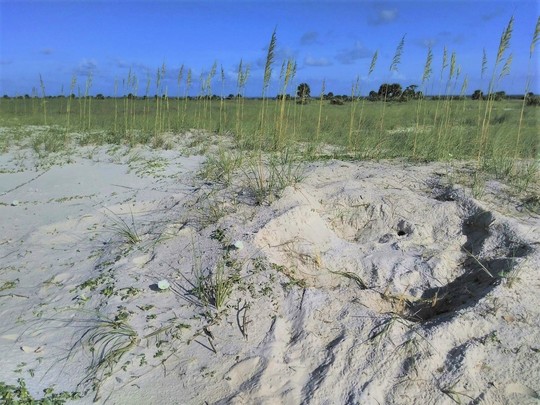Mind the Turtles, Nesting Season is About to Begin
FOR IMMEDIATE RELEASE: May 10, 2021

EASTPOINT, Fla. — Summer sea turtle season is right around the corner. Starting in May, sea turtles—including loggerhead sea turtles, green sea turtles and, very rarely, leatherback sea turtles—will come ashore on Florida’s coastlines and barrier islands to nest. A lucky few visitors and residents might catch a glimpse of these mothers-to-be during their brief return to shore.
Perhaps a more common summertime scene for folks in Franklin County is the St. George Island Volunteer Turtle Patrol. Easily identified by their emblematic ocean-blue shirts, this volunteer group from Apalachicola National Estuarine Research Reserve (NERR) scouts the beaches in search of fresh turtle tracks to observe and chart. They are often seen up to their elbows in the sand or hauling flagging tape to the next nest in need of marking.
This patrol is a long-established and well-known part of Apalachicola NERR’s sea turtle monitoring program. Sea turtles aren’t coming home only to St. George Island (SGI) to nest; their second-favorite stretch of Franklin County is the 9 miles of undeveloped beach on Little St. George Island (LSGI), which lies between St. Vincent National Wildlife Refuge and SGI.
As the 2021 nesting season approaches, Apalachicola NERR volunteers are reminiscing on the successes of last year’s season, especially the nesting territory of Little St. George Island. 2020 was a steady year for nesting sea turtles. LSGI was home to a total of 156 observed sea turtle nests, with 18 nests laid by green sea turtles (Chelonia mydas) and 138 nests by loggerhead sea turtles (Caretta caretta). This amounts to the highest number of green sea turtle nests during any one season recorded on LSGI, which more than doubles the previous record of eight nests in 2017. Apalachicola NERR staff estimate that almost 6,000 loggerhead hatchlings and 1,600 green sea turtle hatchlings emerged from nests on LSGI and trekked toward the Gulf of Mexico.
It also was a record year for the Atlantic hurricane season. Last year brought a record number of named storms (30), nine early-season storms (May through July) and 12 landfalls in the contiguous United States. These storms likely had a significant impact on sea turtle nests across the nation, and they affected many nests on LSGI. At least 52 of the total 156 nests were either completely or partially washed out, or “overwashed.” The two storms with the greatest impact to our area were Tropical Storm Cristobal, making landfall June 6-7, and Hurricane Sally, which landed Sept. 14-16. These storms booked-ended the primary nesting season and brought storm surge that washed away some nests.
While these storm events may seem to be a cause for concern, sea turtles have an adaptable breeding strategy that has developed over time. Within this adaptive strategy, females can lay multiple nests—with upward of 100 eggs in each clutch—throughout the nesting season, often at different locations on their home beach. These strategies give sea turtle hatchlings a strong chance to journey from their nest into the Gulf.
As Floridians welcome the summer and this year’s nesting season, remember these tips to help these endangered animals survive.
- Clean up debris. At the end of each day, pick up all beach chairs, umbrellas, gazebos and trash.
- Keep it dark. Turn off beach lights and use turtle-friendly flashlights at night.
- Keep it flat. Fill holes and knock down sandcastles that might be obstacles to turtles.
Think clean, dark and flat, and the sea turtles will thank you!

Legal Disclaimer:
EIN Presswire provides this news content "as is" without warranty of any kind. We do not accept any responsibility or liability for the accuracy, content, images, videos, licenses, completeness, legality, or reliability of the information contained in this article. If you have any complaints or copyright issues related to this article, kindly contact the author above.
